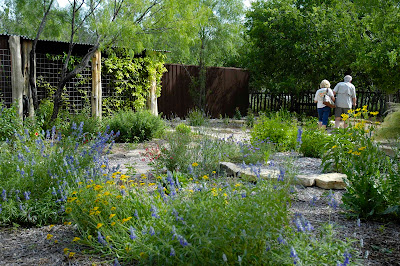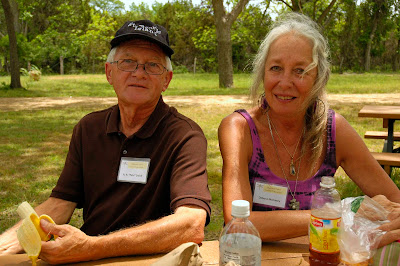 |
| Our day's first outing took us to the bird blinds at Pedernales Falls State Park. |
A year ago, James, my
husband, set out a concrete birdbath and hung a red-plastic hummingbird feeder
outside my office window here at home. Robins, mockingbirds, house finches,
chickadees and other species frequently splash in the birdbath, and black-chinned
hummers drop by the feeder.
Sometimes, it’s hard to
concentrate and work because I’d rather look out the window! (Hence, the name
for my blog.)
On occasion in our
Wildscape, we encounter Gulf coast toads, rat snakes, Texas spiny lizards and rough
earth snakes. Once, I found a mountains patchnose snake on our front porch. He
was cool. Another time, a neighbor brought us an eastern hognose snake. We
watch him puff out his neck and hiss. He lives somewhere in our Wildscape.
From
the Super S Foods parking lot in Johnson City, my classmates and I carpooled to
Pedernales Falls State Park, where we met at the bird observation blinds. Sue
and Sherry, both expert birders and also Master Naturalists with our chapter,
helped us to spot different species.
“Please
talk quietly,” Sue told us. “The louder you talk, the more you scare the
birds.”
First,
most of us stepped into the older wood-frame blind, constructed about 14 years
ago. Some of us perched on wooden benches; others stood. We all gazed through
the huge glass windows, hoping to glimpse an indigo bunting or maybe a painted
bunting.
“Of
course, there has to be one brown-headed cowbird show up,” Sue lamented. “And
they always strut!”
Vern,
a park volunteer for 19 years ago, showed us a big jar of suet that he smears in
holes on logs and cross timbers to attract birds. “They love it, good stuff,”
he said. “We use one cup lard, one cup peanut butter and 5 cups cornmeal in the
summer.”
A
few minutes later, Sherry pointed out an orange-crowed warbler on the water
feature. How’d the pale yellowish bird get its name? “When they’re mating, he
flashes his orange crown,” she replied.
After
awhile, I walked through the native plant garden to the second blind, which
opened two years ago. “The song you’re hearing is the house finch,” commented
Sherry, who walked in behind me. “The indigo bunting’s song is similar, just a little
softer.”
 |
| Pat checked out birds with her binoculars while Joy and Sue spotted with their eyes. |
 |
| Vern, a long-time park volunteer, shared his suet recipe with Sherry. |
 |
| In the older blind, Pete scopes out the trees for birds. |
 |
| Our class filled up the older bird blind! |
 |
| Celia was excited to spot nine species on our outing: indigo bunting, Carolina wren, painted bunting, Nashville warbler, northern cardinal, black-chinned hummingbird, house sparrow, house finch and Carolina chickadee. |
 |
| In the newer bird blind, many of us watched for birds on the water feature. |
 |
| We filled up the newer blind, top! |
 |
| Coral honeysuckle vines cover the entrance to the newer blind. |
 |
| Mealy cup sage, Mexican feather grass, lantanas and other natives inhabit the garden. |
 |
| When I walked past a hackberry tree, a bird flew out. I peeked inside the branches and spotted a nest with two or three eggs. |
 |
| From Pedernales Falls State Park, we drove to the Johnson City Event Center at the Lyndon B. Johnson National Historical Park in Johnson City, where Sherry gave a presentation on birds of the Texas Hill Country. |
 |
| Then we ate our picnic lunches! (That's Becky on the right waving.) |
 |
| Sammye and Mike, our training program leaders, use these birding books. |
 |
| Sammmye went table to table, showing us the books. |
 |
| Betty, who's assisting Mike and Sammye, showed M.J. a bird-call app. |
 |
| Meet the rest of my classmates: Judy and Vicki.... |
 |
| Fred and Kevin.... |
 |
| Pat and Kay (sorry you turned out fuzzy, Kay).... |
 |
| Pete and Debra... |
 |
| Ed and Dan... |
 |
| Ed and Tom... |
 |
| Becky and Joy.... |
 |
| Barbara, Eva and Janis... |
 |
| Celia and M.J. (Wayne was absent this week, and we missed him! |
 |
| Robert Lindsey, a retired manager of the Inks Dam National Fish Hatchery gave a program on Texas herps. (His head will show up in later photos.) "I don't handle venomous snakes because I may be allergic to the anti-venom," he said. First, he showed us a red-striped ribbon snake, the region's most common snake. |
 |
| Checkered garter snake |
 |
| Rough earth snake and Texas brown snake |
 |
| Water snake |
 |
| Eastern hognose snake |
 |
| Western coachwhip |
 |
| Western coachwhip again |
 |
| Texas rat snake |
 |
| Mikey, a three-year-old bull snake |
 |
| For a snake, Mikey was very personable. |
 |
| On to lizards: Texas spiny lizard (left) and southern prairie lizard. |
 |
| Crevice lizard |
 |
| This is how Robert gets a crevice lizard to show off his blue underside (ouch). |
 |
| Short-lined skink |
 |
| Texas spotted whiptail |
 |
| Mama, a Gulf coast toad |
 |
| Robert also brought Texas river cooters and other turtles, which stayed in their tub. |
 |
| Joanne, a Master Naturalist with our chapter, loved holding Mikey. |
 |
| Debra held Mikey, too... |
 |
| ...and so did I! |
Resources
Sue's suet recipe
1 cup crunchy
1 cup lard
2 cups quick cook oats
2 cups cornmeal
1 cup flour
Melt lard and peanut butter in microwave or over low heat. Stir in remaining ingredients and pour into square freezer containers about 1/2 inches thick (to fit your suet baskets). Store in freezer until ready to use. This makes about 6 suet cakes. It's fun to make, and my birds just love it.
Birding websites
Cornell Lab of Ornithology
Birds.com (Texas info)
Texas Birds Info
Meet the Birds of Texas
Texas Hummingbird Roundup
 |
| Robert Lindsey's herp books |
NEXT WEEK
Our class curriculum takes
us Oatmeal Community Center and the Hutson Ranch, where we'll study mammals and rangeland management.




















































